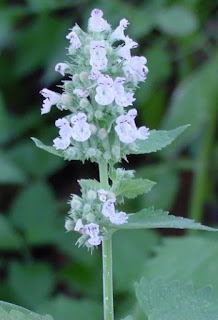
Catnip foliage:

According to Dr. T. Ombrello - UCC Biology Department:
Individuals interested in cultivating Catnip are advised to sow the seeds directly into the garden and be especially careful not to injure developing plants (releasing the volatile oil) or the neighborhood cats will destroy the crop. The following bit of English folklore says it all.
If you set it, the cats will eat it. If you sow it, the cats won’t know it.
Native to Eurasia, Catnip has been transported around the world by people and has become naturalized in many areas, including the United States. This perennial herb is a member of the Mint family of plants (Lamiaceae) and is very closely related to Spearmint and Peppermint. The plant can reach 3 feet in height and is readily distinguished by its hairy, gray colored leaves and stems. The plant blooms in the summer with clusters of 3/8-inch flowers at the tips of the shoots. The blossoms are 2-lipped with white and purple spotted petals.
Besides being grown for the enjoyment of pet cats, Catnip has a history of use as a beverage and a medicine. Before European trade with China began bringing large quantities of fine Eastern Tea to Europe, Catnip tea was a domestic favorite especially among tea loving residents of the British Isles. When growing the plant for this purpose, mature leaves should be collected while they are still fresh and dried in the shade (not in the sun, or the volatile oil will be lost) for several days. One teaspoon of the dried herb is then added to each cup of boiling water and allowed to steep. The tea should not be boiled or, again, the oil will be lost. The drink is an excellent source of vitamin C.
The number of various uses of Catnip tea for medicinal purposes is extraordinary. A survey of the literature indicates that it has been used at one time or another to cure just about every human disorder. Some of its more popular uses in Europe would include curing chronic bronchitis, diarrhea, upset stomachs, infant colic, flatulency, spasms, and “various lower type female disorders”. The tea is said to induce perspiration and has been used to break fevers, bring on sleep, and to cool a person down on a hot summer day.
Catnip, because it is a member of the mint family, will spread, so plant it where it will have room to grow. It can be used in similar ways to chamomile - to calm the nerves or the stomach, as a teething pain reliever, and most interestingly, an insect repellent (which I have yet to try, but plan to).
Since I'm too impatient to wait for my own crop to grow, cultivate the oil, and make my own from scratch, I'm more likely to buy the essential oil at Sunny Farms (10$) and make it that way. Living near several areas with stagnant water means lots of mosquitoes - so I will have plenty of opportunity to tests its effectiveness.
This will be the next addition to our little herb garden.
And P.S. The all-natural, homemade all-purpose cleaner is working out great! It smells good and cleans well (even grease). Even does the stainless steel appliances in the kitchen! I would definitely suggest it. (15 drops lavender oil, 15 drops, tea tree oil, 2 cups water, and a few drops of natural soap - I just used the "environmentally friendly" dish soap from Costco). One variation I plan to try is using spearmint oil or eucalyptus for a change in fragrance.
No comments:
Post a Comment